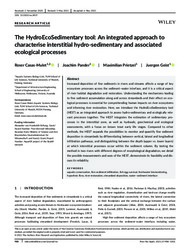The HydroEcoSedimentary tool: An integrated approach to characterise interstitial hydro‐sedimentary and associated ecological processes
DOI: https://doi.org/10.1002/rra.3819
Persistent URL: http://resolver.sub.uni-goettingen.de/purl?gldocs-11858/9832
Persistent URL: http://resolver.sub.uni-goettingen.de/purl?gldocs-11858/9832
Casas‐Mulet, Roser; Pander, Joachim; Prietzel, Maximilian; Geist, Juergen, 2021: The HydroEcoSedimentary tool: An integrated approach to characterise interstitial hydro‐sedimentary and associated ecological processes. In: River Research and Applications, Band 37, 7: 988 - 1002, DOI: 10.1002/rra.3819.
 |
Dokument öffnen: |
Increased deposition of fine sediments in rivers and streams affects a range of key ecosystem processes across the sediment–water interface, and it is a critical aspect of river habitat degradation and restoration. Understanding the mechanisms leading to fine sediment accumulation along and across streambeds and their effect on ecological processes is essential for comprehending human impacts on river ecosystems and informing river restoration. Here, we introduce the HydroEcoSedimentary tool (HEST) as an integrated approach to assess hydro‐sedimentary and ecologically relevant processes together. The HEST integrates the estimation of sedimentary processes in the interstitial zone, as well as hydraulic, geochemical and ecological assessments, with a focus on brown trout early life stages. Compared to other methods, the HEST expands the possibilities to monitor and quantify fine sediment deposition in streambeds by differentiating between vertical, lateral and longitudinal infiltration pathways, and distinguishing between the depth (upper vs. lower layers) at which interstitial processes occur within the sediment column. By testing the method in two rivers with different degrees of morphological degradation, we detail the possible measurements and uses of the HEST, demonstrate its feasibility and discuss its reliability.
Statistik:
ZugriffsstatistikSammlung:
- Geographie, Hydrologie [454]
Schlagworte:
aquatic conservationfine sediment infiltration
fish egg survival
freshwater biomonitoring
hyporheic flow
river restoration
streambed deposition
water–sediment interface
This is an open access article under the terms of the Creative Commons Attribution‐NonCommercial License, which permits use, distribution and reproduction in any medium, provided the original work is properly cited and is not used for commercial purposes.

